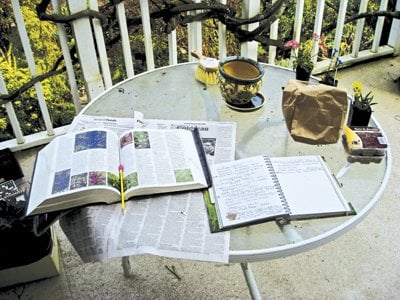Phuket Gardening: Books on tropical gardening

PHUKET: Much of the knowledge one acquires about plants is learnt in the acid-bath of experience. And certainly there is no substitute for hands-on gardening. How often we find ourselves puzzled by the advice we find in books by so-called “experts”.
Nonetheless, we often do need to check things – names, cultural requirements, growing habits and so on. And different books are useful in different ways.
The very first book I bought in Thailand has proven to be one of the most serviceable.
Its dog-eared appearance testifies to that. Entitled, A Field Guide to Tropical Plants of Asia, its authors, David Engel and Suchart Plummai, have conveniently divided things into main sections: trees, listed by flower, foliage and fruit; shrubs, vines and ground cover plants are all classified in the same way.
Flowers are grouped according to color: red, pink, yellow and white. Each description of flower, fruit or foliage, is accompanied by a color photograph (300 in all).
Botanical names are followed by common English ones and Thai phonetic equivalents.
Especially useful if you are visiting a plant nursery. Just open the appropriate page and sing out the Thai name.
First published in 2000, by Marshall Cavendish, it has been reprinted many times – an indication of its enduring popularity.
It retails at around 900 baht. Some information about nomenclature is out of date, but then there is an ongoing discussion about plant categories.
Tropical Garden Plants, by William Warren, (Thames and Hudson, 2001) is a more substantial opus, with 449 color illustrations. It has more information about each entry, and the photographs, by a professional, are especially fine.
My main cavil is that while the chapters are logical enough – trees, shrubs, annuals, foliage plants, vines and so on – the non-alphabetical arrangement means constant forays into the index to locate a particular species.
Having said that, its later sections on exotics, water plants, palms and orchids might usefully be emulated by other writers.
An odd title for a seriously weighty tome, Plant Materials in Thailand, by Uamporn Veesommai and Thaya Janjitikul, is the closest you will get to an exhaustive, yet compendious reference book.
Primarily for local consumption with plants indexed alphabetically in Thai, there is a helpful parallel text in English and 1,320 photographs of the country’s flora. It has, once and for all, solved the myriad of questions I have had over the years about flowering tropical plants. If you want to put a name to a floral face, you will assuredly find the answer here. Expensive, but encyclopedic. A must for the serious gardener.
In the quest for good horticultural books, I have extended the net beyond Thailand. Two books match the detail of plant materials. One is the self – explanatory Complete Encyclopedia of Trees and Shrubs (Thunder Bay Press, 2001).
Published in California, I picked up my copy in Sri Lanka, of all places. Compiled by a large team, it does not cover non-shrubby flowers, and has a distinct North American bias, which means that, “south of the border, down Mexico way”, is dealt with less comprehensively. Vines are excluded. Small cavils in a book that describes 8,500 woody plants, many illustrated. It is superb on trees. Another remarkable piece of botanical research.
Coincidentally, last year at the bookshop of California’s Stanford University I discovered Western Garden. West Coast America is not Thailand, and this book consequently has limitations. Moreover, the illustrations are mostly the work of artists – good in themselves, but no substitute for photographs. But both coverage and organization are excellent: plants are described alphabetically according to their botanical names, and the cultivation notes are very full. Yet another book for the keen gardener.
Tip of the week: Separation and division
At various times, I have talked about propagating and reproducing plants by seed, layering, cuttings and division. Some so-called “mother plants” give birth to plantlets, which can be separated from their parent.
I was reminded of separation and division after reading a piece written by Normita Thongtham in which she visits a garden that specializes in ferns.
Ferns mostly regenerate by producing tiny spores, which appear on the underside of leaves. And, like many seeds, these spores can result in new plants which are “sports” or mutations, quite different from the parent. As the fern grower remarked of a neprolepis fern: “I’ve never seen one (new plant), which grew to look exactly like it”. Fascinating.
But, if you must have an exact copy of the parent, the only way is by plant division. This is the best method for most gingers, cannas and heliconias – as well as ferns.
If you have a question or a garden that you would like featured, you can email the author here.
Keep checking our online Phuket Lifestyle pages or join our Facebook fan page for regular gardening features and tips.
— Patrick Campbell
Latest Thailand News
Follow The Thaiger on Google News:


























